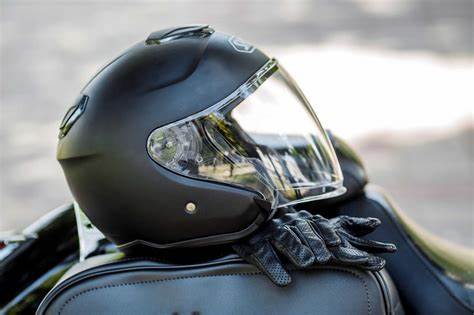If you’re a typical motorcycle rider, you likely anticipate hitting the road at the first sign of spring. As such, you dust off your bike, fill it with fresh gasoline, and start it up. However, it’s essential to take a critical look at your safety equipment as well. The reality is that not only does your gear wear out, but it can also become outdated in terms of safety. Admittedly, new gear can be costly. But if you’re serious about being visible to other drivers and surviving a crash, the added expense is worthwhile.

Helmets have a lifespan of only five years or a single collision. We are not referring to situations where your helmet is dropped. However, if your head was inside the helmet when it made contact with the ground, you should not consider using it again. The energy-absorbing foam materials are not designed to withstand multiple impacts.
Over time, the foam materials deteriorate and begin to lose some of their impact resistance. Additionally, the outer shell begins to deteriorate due to UV exposure. So, check the date on the label, and if it is approaching or exceeding the five-year mark, replace it. Then, gently flex the shell and search for cracks or deep gouges, as well as inspect the foam for cracks or degradation. Also, check the visor for scratches. If you find any signs of damage, replace it with a new helmet.
Over time, the foam materials degrade and lose some of their impact resistance. Additionally, the outer shell begins to deteriorate due to UV exposure. Therefore, check the label’s date and replace your helmet if it’s approaching or exceeding the five-year mark. Then, gently flex the shell and inspect it for cracks or deep gouges, as well as check the foam for cracks or degradation. Also, inspect the visor for scratches. If you notice any signs of damage, replace your helmet with a new one.
If you are in the market for a new helmet, you will find that prices range from less than $100 to $1,500. A budget helmet that meets the Department of Transportation (DOT) safety standards offers basic features for comfort and safety, while a high-end helmet is made from lightweight carbon fiber with advanced impact protection and superior comfort.
Although DOT standards are widely recognized, some experts recommend buying a helmet that meets more rigorous safety standards such as ECE, SNELL or SHARP (refer to “DOT, ECE, SNELL, and SHARP Certifications” on the left). However, a cheap helmet that fits properly provides better protection than a more expensive helmet that doesn’t fit well. Therefore, it is best to buy your helmet locally, where you can get product advice and fitting help from knowledgeable salespeople, rather than buying online or through catalogs.
Apart from choosing a helmet that matches your riding style (e.g. touring, racing, off-road), here are some additional tips from experts:
Full-face helmets with a face shield and fixed chin guard offer the best protection in the event of an accident.
Open-face helmets provide better visibility and ventilation but less impact protection.
Half helmets provide the most ventilation and visibility but provide only minimal protection.
Modular helmets enable you to flip up the chin bar for refueling or eating, but they are not as safe as a full-face helmet.
Novelty helmets that lack DOT certification might allow you to meet state helmet laws, but they provide little protection and are similar to strapping a salad bowl to your head.
Wearing high-visibility clothing can significantly increase your chances of survival on the road, as motorcycles are often overlooked by inattentive drivers.
Translation:
When it comes to helmet selection, there is a wide range of prices, with some helmets costing less than $100 and others costing up to $1,500. A low-cost helmet meets the Department of Transportation (DOT) minimum safety standards and provides some basic comfort features, whereas a high-end helmet is made of carbon fiber and has superior impact protection and comfort.
0 comment
I upgraded to a reflective motorcycle vest and it’s made me much more visible to other drivers, especially at night. – Mike, safety-conscious rider.
This traffic is really bad.
I need to find a new hobby.
I was in a serious accident and my riding gear saved my life. I always encourage others to invest in quality gear and upgrade as necessary. – Alex, motorcycle accident survivor.
Upgrading my riding boots to ones with ankle protection has given me more confidence and stability on the bike. – Lisa, adventure rider.
I need to take my dog for a walk.
Upgrading your safety gear can also make a big difference in your comfort level while riding. I upgraded to a better pair of gloves and it’s made a huge difference in my overall riding experience. – Jen, weekend rider.
I’m not in the mood to exercise.
I always wear a full-face helmet, but upgrading to one with a wider visor has greatly improved my visibility and peripheral vision. – Tim, motorcycle racer.
I’m not sure what to have for lunch.
I can’t find my favorite pen.
As an experienced rider, I always recommend upgrading your motorcycle safety gear to new riders. It can make all the difference in an accident. – John, motorcycle instructor.
I upgraded my helmet to one with a MIPS system and it’s been a game-changer for me. I feel much more confident and safer on the road. – Sarah, motorcycle enthusiast.
I upgraded to a motorcycle jacket with built-in armor and I can definitely feel the difference in protection. It’s worth the investment. – David, daily motorcycle commuter.
I think I need to buy some new shoes.
I wish I had a snack right now.
I’m feeling a bit tired today.
I need to buy some new socks.